Pradosh Vrat, also known as Pradosham, is an important vrat (fast) observed by Hindus to seek the blessings of Lord Shiva. It falls on the Trayodashi (13th day) of both the lunar fortnights (Shukla Paksha and Krishna Paksha) of the Hindu calendar month. The time of Pradosh Kaal, just before sunset, is considered highly auspicious for worshipping Lord Shiva and seeking his divine grace. In this article, we will delve into the timings, significance, and rituals associated with Pradosh Vrat.
Significance of Pradosh Vrat:
Pradosh Vrat holds great significance in Hindu mythology and scriptures. It is believed that observing this vrat with dedication and devotion can help devotees attain peace, prosperity, and spiritual upliftment. The legend goes that during the churning of the ocean (Samudra Manthan), a pot of poison (halahala) emerged, threatening to destroy the world. Lord Shiva, to save the universe, consumed the poison but held it in his throat, turning his throat blue, earning him the name Neelkanth. The Pradosh period is considered the ideal time to worship Lord Shiva and seek his blessings for protection against negativity and obstacles.
Pradosh Vrat Timings:
Pradosh Vrat is observed twice a month, once during the waxing phase of the moon (Shukla Paksha) and once during the waning phase (Krishna Paksha). The timing for observing Pradosh Vrat is crucial, and it is recommended to break the fast only after the Pradosh Kaal ends. The duration of Pradosh Kaal may vary depending on the geographical location and sunrise/sunset timings. It is advisable to consult a Hindu Panchang or astrologer for precise timings. Typically, the Pradosh Kaal overlaps with the time just before sunset.
Pradosh Vrat Rituals:
The devotees who observe Pradosh Vrat follow a set of rituals to please Lord Shiva and seek his blessings. Some of the common rituals include:
1. Abstinence: Devotees are expected to observe a fast from sunrise to sunset on the day of Pradosh Vrat. Some may prefer to keep a partial fast by consuming fruits or milk.
2. Puja preparations: Cleanse the home and the puja area. Set up a Shiva Lingam or image of Lord Shiva, along with other puja items like incense, flowers, and fruits.
3. Puja Vidhi: Perform Rudrabhishekam or abhishekam with water, milk, honey, curd, ghee, and bilva leaves while chanting mantras dedicated to Lord Shiva.
4. Offerings: Offer bael leaves, bael fruit, datura, milk, curd, honey, ghee, and water to Lord Shiva. Light a diya (lamp) and dhoop (incense) during the puja.
5. Chanting and meditation: Recite Shiva Mantras like the Maha Mrityunjaya Mantra or the Mahamrityunjaya Mantra with utmost devotion. Meditate on Lord Shiva and seek his blessings.
6. Arati: Conclude the puja by performing the aarti of Lord Shiva and seeking his blessings for the well-being of the family and loved ones.
FAQs (Frequently Asked Questions):
1. Can anyone observe Pradosh Vrat?
- Yes, Pradosh Vrat can be observed by both men and women. It is believed to bring prosperity and remove obstacles from life.
2. What should one eat during Pradosh Vrat?
- Devotees observing Pradosh Vrat usually consume sattvic food like fruits, milk, and dry fruits. Some may opt for a partial fast as well.
3. Is it necessary to visit a temple to observe Pradosh Vrat?
- While visiting a temple for Pradosh Vrat is considered auspicious, one can observe the vrat with devotion at home as well.
4. Can Pradosh Vrat be observed without fasting?
- Ideally, Pradosh Vrat is observed with a fast. However, those unable to keep a full fast can opt for a partial fast by consuming fruits or milk.
5. Is there a specific mantra for Pradosh Vrat?
- Chanting the Maha Mrityunjaya Mantra or the Rudra Gayatri Mantra is highly recommended during Pradosh Vrat for blessings and protection.
6. What are the benefits of observing Pradosh Vrat?
- Observing Pradosh Vrat is believed to bring peace, prosperity, removal of sins, and fulfillment of desires. It is also considered auspicious for couples seeking progeny.
7. Can Pradosh Vrat be observed without a priest?
- Yes, Pradosh Vrat can be observed without a priest. Devotees can perform the rituals at home by following the proper procedures and mantras.
8. Does Pradosh Vrat have any specific rules or taboos?
- It is advisable to avoid consuming non-vegetarian food, alcohol, and engaging in negative activities during Pradosh Vrat. Observing cleanliness and purity is essential.
9. What is the significance of offering bilva leaves to Lord Shiva during Pradosh Vrat?
- Bilva leaves are considered sacred and dear to Lord Shiva. Offering bilva leaves during Pradosh Vrat is believed to please Lord Shiva and bring blessings.
10. Can Pradosh Vrat be observed for specific wishes or intentions?
- Devotees can observe Pradosh Vrat with specific wishes or intentions in mind. It is believed that sincere prayers during this auspicious time are often fulfilled by Lord Shiva.
In conclusion, observing Pradosh Vrat with faith, devotion, and adherence to the prescribed rituals can bestow immense blessings and grace from Lord Shiva. It is a time to seek solace, protection, and spiritual growth, reaffirming one’s connection with the divine. Embracing the significance of Pradosh Vrat can lead to inner transformation and a sense of peace and fulfillment in one’s life.












